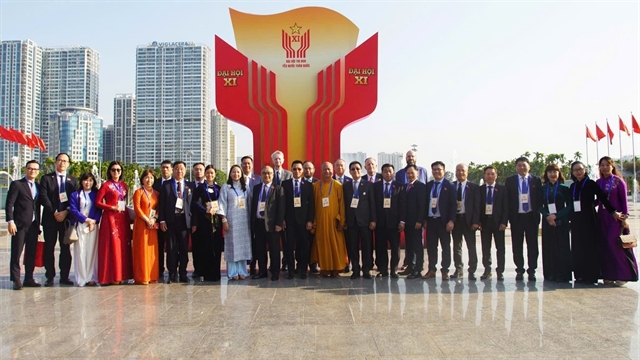 Life & Style
Life & Style

Artist Nguyễn Quốc Dân, chosen as the “new face” by Japanese NHK television programme Takeshi Art Beat, speaks about his latest exhibition and his career.
 |
Artist Nguyễn Quốc Dân’s fourth solo exhibition is being held at 12 Nguyễn Huệ Street, HCM City.
Eleven of the artist’s oil-on-canvas paintings of a large size, 2m x 2m to 2m x 5m, are being displayed at the exhibition titled Phi Lập Thể - Chân Dung 2016 (Portrait - Non-Cubism 2016).
After graduating from the HCM Fine Arts College, Dân had his debut solo exhibition, showcasing his artwork in which all the objects were formed by “colour cords”. He has, so far, always used “colour cords” to present his ideas.
The artist was chosen as the “new face” by Japanese NHK television programme Takeshi Art Beat, dedicated to promoting new genres of art and introducing new artists.
Nguyễn Quốc Dân speaks about his latest exhibition and his career.
What made you show your paintings at Portrait - Non-Cubism 2016 and are you satisfied with the exhibition?
I simply wanted to express my inner emotions through portrait paintings with this exhibition. The exhibition is the story of my inner self, which is very unusual for me.
I thought this exhibition would be larger. But it is not. I really want to organise many more exhibitions on a larger scale.
When did you engage in the non-Cubist style and what does painting mean to you?
Actually, I followed this style intuitively, based on my knowledge and research. While I was a student at fine arts college I did small research for my own purpose and I have followed it since then.
Art brings to me a different level of understanding. If the paintings are too difficult to understand, the people will not relate to them. I think these paintings make me emotional and inspire me to be more creative.
Why do you usually use “colour cords” in your paintings?
Each artist chooses his own technique to express his art, such as form, lay-out, rhythm and colour.
However, knowledge and a strong background are very important.
At present, a combination of cord and “colour cord” is my style. I will have a new combination in the future, which may appear strange. I think one needs to encourage creativity in art even if it leads to contrasting opinions. It depends on different angles.
Can you tell us why you haven’t sold your paintings and how do you earn money?
Right now, selling paintings is not important. The most important things is whether my paintings are valuable or not, and is there something new in my paintings to be seen.
I don’t like to paint for sale or to meet a personal demand in my daily life. I’m bored with life. I haven’t got married. I’m afraid of losing myself to money.
Many people, including fine arts students, say a painter only knows how to paint and cannot do some other work. This is a general sentence and very subjective.
I think a painter can do different types of work. There is a lot of work in the practice of fine arts and I can do that.
Why did you become a painter?
I was born in the central province of Quảng Nam and underwent several hardships during my childhood.
When I was three, my mother took me to a new land and we were homeless for seven years. During the time, I earned a living by selling newspapers, iced tea, washing dishes and cleaning restaurants.
I stopped primary school education as my mother couldn’t afford my studies. I was sent to an orphanage in Hội An in the central province of Quảng Nam.
The charming beauty of the ancient town lured my teenage boy’s mind into expressing my thoughts on paper.
Since then, I have fallen in love with painting. However, I had to wait a few years before I could learn to paint thanks to the support of two kind-hearted Western men, who realised my passion for the art. — VNS




